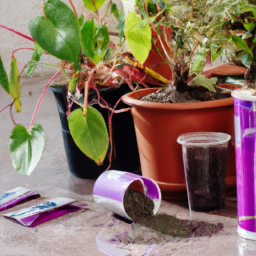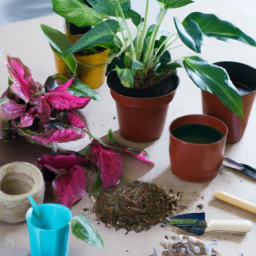
Are you looking for the best potting mix for your indoor plants? Choosing the right potting mix is crucial for the health and growth of your plants. With so many options available on the market, it can be overwhelming to decide which one is best suited for your indoor garden. In this blog post, we will explore the different types of potting mixes and help you determine the best one for your indoor plants. So, let’s dive in and find the perfect mix to keep your plants thriving!
Benefits of Using the Best Potting Mix for Indoor Plants
When it comes to caring for indoor plants, one of the most important factors to consider is the type of potting mix you use. The right potting mix can make a world of difference in the health and growth of your plants. Here are some of the key benefits of using the best potting mix for indoor plants:
Improved Drainage
One of the main benefits of using a high-quality potting mix is improved drainage. Good drainage is essential for the health of your plants, as it helps prevent waterlogged soil and root rot. The best potting mixes are specifically designed to allow excess water to drain away quickly, while still retaining enough moisture for the plant to thrive.
When choosing a potting mix for your indoor plants, look for one that contains ingredients like perlite, vermiculite, or sand, which help to improve drainage. Avoid mixes that are heavy and compacted, as these can lead to waterlogging and other issues.
By using a potting mix with good drainage, you can help ensure that your indoor plants stay healthy and happy for years to come.
Optimal Nutrient Levels
Another benefit of using the best potting mix for indoor plants is that it provides optimal nutrient levels for your plants. A high-quality potting mix will contain a balanced blend of nutrients, including nitrogen, phosphorus, and potassium, as well as trace minerals like calcium, magnesium, and sulfur.
These nutrients are essential for the growth and development of your plants, helping them to produce vibrant foliage, beautiful flowers, and strong roots. By using a potting mix that is rich in nutrients, you can give your indoor plants the best possible chance of thriving.
When shopping for a potting mix, look for one that is labeled as “complete” or “balanced,” indicating that it contains a full range of essential nutrients. Avoid mixes that are labeled as “sterile,” as these may lack the nutrients your plants need to grow.
Enhanced Aeration
In addition to improved drainage and optimal nutrient levels, the best potting mix for indoor plants also provides enhanced aeration. Aeration is important for the health of your plants, as it helps to promote root growth and prevent soil compaction.
Good potting mixes contain ingredients like perlite, which help to create air pockets in the soil, allowing oxygen to reach the roots of your plants. This helps to keep the roots healthy and strong, ensuring that your plants can absorb nutrients and water more effectively.
When choosing a potting mix, look for one that is light and fluffy, with plenty of aeration. Avoid mixes that are heavy and dense, as these can suffocate the roots of your plants and lead to poor growth.

How to Choose the Best Potting Mix for Your Indoor Plants
Understanding the Importance of Potting Mix for Indoor Plants
Choosing the right potting mix for your indoor plants is crucial for their overall health and growth. The potting mix provides essential nutrients, moisture retention, and aeration for the roots of your plants. It also plays a key role in preventing diseases and pests from affecting your plants.
When selecting a potting mix, it’s important to consider the specific needs of your indoor plants. Different types of plants require different levels of moisture, nutrients, and drainage. By choosing the right potting mix, you can ensure that your plants thrive and continue to beautify your indoor space.
There are a variety of potting mixes available on the market, each tailored to specific types of plants and growing conditions. By understanding the key components of potting mixes and how they can benefit your indoor plants, you can make an informed decision when selecting the best potting mix for your plants.
Key Components of a High-Quality Potting Mix
When choosing a potting mix for your indoor plants, it’s important to look for a mix that contains a balanced combination of organic matter, perlite or vermiculite, and other essential nutrients. Organic matter, such as peat moss or coconut coir, helps retain moisture and provides a stable environment for root growth.
Perlite and vermiculite are lightweight materials that improve aeration and drainage in the potting mix. They prevent the soil from becoming compacted, allowing the roots to access oxygen and nutrients more easily. Additionally, a high-quality potting mix should contain essential nutrients such as nitrogen, phosphorus, and potassium to support healthy plant growth.
It’s also important to consider the pH level of the potting mix, as different plants require different levels of acidity or alkalinity to thrive. Most indoor plants prefer a slightly acidic pH level, so choosing a potting mix with a pH between 6.0 and 7.0 is ideal for most houseplants.
Tips for Choosing the Best Potting Mix for Your Indoor Plants
When selecting a potting mix for your indoor plants, consider the specific needs of each plant species. Some plants, such as succulents and cacti, require a well-draining mix with minimal moisture retention, while others, like ferns and tropical plants, thrive in a mix that retains more moisture.
Before repotting your indoor plants, assess the current condition of the roots and soil. If the roots are compacted or the soil is waterlogged, it’s time to repot your plant in a fresh potting mix. Choose a mix that is tailored to the specific needs of your plant species to ensure optimal growth and health.
It’s also important to monitor the moisture levels of your indoor plants regularly and adjust your watering schedule accordingly. Overwatering can lead to root rot and other fungal diseases, while underwatering can cause the plant to become dehydrated and wilt. By choosing the right potting mix and maintaining proper watering practices, you can help your indoor plants thrive and flourish.

Top Recommendations for the Best Potting Mix for Indoor Plants
Choosing the Right Potting Mix
When it comes to indoor plants, choosing the right potting mix is crucial for their health and growth. The best potting mix for indoor plants should provide adequate drainage, aeration, and nutrients to support plant growth. Here are some top recommendations for the best potting mix for indoor plants:
1. Peat Moss-Based Mix
Peat moss-based potting mixes are a popular choice for indoor plants because they provide excellent moisture retention and aeration. Peat moss is a natural, organic material that helps retain water while also allowing for proper drainage. This type of potting mix is ideal for plants that prefer slightly acidic soil, such as ferns and African violets.
When using a peat moss-based mix, it’s important to add perlite or sand to improve drainage and prevent the soil from becoming too compacted. You can also mix in some compost or organic matter to provide additional nutrients for your plants.
Overall, peat moss-based potting mixes are a great option for a wide variety of indoor plants, as they provide the right balance of moisture retention and aeration for healthy plant growth.
2. Coco Coir Mix
Coco coir, also known as coconut coir, is another popular choice for indoor plant potting mixes. It is a sustainable alternative to peat moss and is made from the fibrous husks of coconuts. Coco coir has excellent water retention properties and is also resistant to mold and bacteria growth.
When using a coco coir mix, it’s important to mix in some perlite or vermiculite to improve drainage and aeration. You can also add some compost or organic matter to provide essential nutrients for your plants. Coco coir mixes are ideal for plants that prefer slightly acidic soil, such as orchids and tropical plants.
Overall, coco coir potting mixes are a great option for indoor plants, as they provide excellent moisture retention and aeration while also being environmentally friendly.
3. All-Purpose Potting Mix
If you’re looking for a versatile potting mix that can be used for a wide variety of indoor plants, an all-purpose potting mix is a great option. These mixes typically contain a blend of peat moss, perlite, vermiculite, and other organic materials to provide a balanced mix of moisture retention, drainage, and nutrients.
When using an all-purpose potting mix, it’s important to check the specific needs of your plants and adjust the mix accordingly. You can add additional perlite for plants that prefer well-draining soil, or mix in some compost for plants that require more nutrients.
Overall, all-purpose potting mixes are a convenient option for indoor plants, as they provide a good balance of moisture retention, drainage, and nutrients for healthy plant growth.
In Summary
Choosing the best potting mix for your indoor plants is essential for their health and growth. The right mix will provide the necessary nutrients and drainage to keep your plants thriving. When selecting a potting mix, it’s important to consider the type of plants you have and their specific needs. Some plants may require a mix with more moisture retention, while others may benefit from a mix with better aeration.
One popular option for indoor plants is a mix that includes peat moss, perlite, and vermiculite. This combination provides good drainage while also retaining moisture, making it suitable for a wide range of plants. Another option is a mix that includes coconut coir, which is a sustainable alternative to peat moss. Whichever mix you choose, be sure to repot your plants every year or so to refresh the soil and provide them with the nutrients they need to thrive.
Your Questions Answered. Comprehensive FAQ:
Q1: What is the best potting mix for indoor plants?
A1: The best potting mix for indoor plants is one that is well-draining, lightweight, and nutrient-rich. Look for mixes specifically formulated for indoor plants, as they often contain a blend of peat moss, perlite, and vermiculite.
Q2: Can I use regular garden soil for indoor plants?
A2: It is not recommended to use regular garden soil for indoor plants, as it tends to compact and may not provide adequate drainage. Indoor plants thrive in a lighter, more aerated potting mix.
Q3: How often should I repot my indoor plants with new potting mix?
A3: Indoor plants should be repotted with fresh potting mix every 1-2 years, or when you notice the plant outgrowing its current container. Repotting helps refresh the nutrients available to the plant and prevents root-bound issues.
Q4: Can I make my own potting mix for indoor plants?
A4: Yes, you can make your own potting mix for indoor plants by combining equal parts peat moss, perlite, and vermiculite. You can also add compost or organic matter for additional nutrients.
Q5: How do I know if my indoor plants need repotting with new potting mix?
A5: You may need to repot your indoor plants if you notice roots growing out of the drainage holes, the plant becoming top-heavy, or the soil drying out quickly after watering. Additionally, if your plant is not thriving despite proper care, it may be time to repot with fresh potting mix.

James Wong is a renowned ethnobotanist, plant scientist, and local television presenter. With a passion for demystifying plant science, he is known for translating complex botanical concepts into practical advice for everyday plant enthusiasts. James’s expertise spans from traditional gardening to cutting-edge plant technologies, making his insights accessible and informative.


